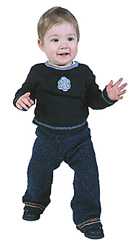Diagnosis

Fetal alcohol spectrum disorders (FASDs) are a group of conditions that can occur in a person whose mother drank alcohol during pregnancy. These effects can range from mild to severe. They can affect each person in different ways and can include physical problems and problems with behavior and learning. The term FASDs is not intended as a clinical diagnosis.
CDC worked with a group of experts and organizations to review the research and develop guidelines for diagnosing fetal alcohol syndrome (FAS). The guidelines were developed for FAS only. CDC and its partners are working to put together diagnostic criteria for other FASDs, such as alcohol-related neurodevelopmental disorder (ARND). Clinical and scientific research on these conditions is going on now.
Guidelines for Diagnosing FAS
Deciding if a child has FAS takes several steps. There is no one test to diagnose FAS, and many other disorders can have similar symptoms. Following is an overview of the diagnostic guidelines for FAS. For more detail, see the full text Fetal Alcohol Syndrome: Guidelines for Referral and Diagnosis for healthcare providers and other clinicians.
These criteria have been simplified for a general audience. They are listed here for information purposes and should be used only by trained health care professionals to diagnose or treat FAS.
Healthcare professionals look for the following signs and symptoms when diagnosing FAS:
- Abnormal facial features
A person with FAS has three distinct facial features:- Smooth ridge between the nose and upper lip (smooth philtrum)
- Thin upper lip
- Short distance between the inner and outer corners of the eyes, giving the eyes a wide-spaced appearance.
- Growth problems
Children with FAS have height, weight, or both that are lower than normal (at or below the 10th percentile). These growth issues might occur even before birth. For some children with FAS, growth problems resolve themselves early in life. - Central nervous system problems
The central nervous system is made up of the brain and spinal cord. It controls all the workings of the body. When something goes wrong with a part of the nervous system, a person can have trouble moving, speaking, or learning. He or she can also have problems with memory, senses, or social skills. There are three categories of central nervous system problems:- Structural
FAS can cause differences in the structure of the brain. Signs of structural differences are:- Smaller-than-normal head size for the person’s overall height and weight (at or below the 10th percentile).
- Significant changes in the structure of the brain as seen on brain scans such as MRIs or CT scans.
- Neurologic
There are problems with the nervous system that cannot be linked to another cause. Examples include poor coordination, poor muscle control, and problems with sucking as a baby. - Functional
The person’s ability to function is well below what’s expected for his or her age, schooling, or circumstances. To be diagnosed with FAS, a person must have:- Cognitive deficits (e.g., low IQ), or significant developmental delay in children who are too young for an IQ assessment.Or
- Problems in at least three of the following areas:
- Cognitive deficits (e.g., low IQ) or developmental delays
Examples include specific learning disabilities (especially math), poor grades in school, performance differences between verbal and nonverbal skills, and slowed movements or reactions. - Executive functioning deficits
These deficits involve the thinking processes that help a person manage life tasks. Such deficits include poor organization and planning, lack of inhibition, difficulty grasping cause and effect, difficulty following multistep directions, difficulty doing things in a new way or thinking of things in a new way, poor judgment, and inability to apply knowledge to new situations. - Motor functioning delays
These delays affect how a person controls his or her muscles. Examples include delay in walking (gross motor skills), difficulty writing or drawing (fine motor skills), clumsiness, balance problems, tremors, difficulty coordinating hands and fingers (dexterity), and poor sucking in babies. - Attention problems or hyperactivity
A child with these problems might be described as “busy,” overly active, inattentive, easily distracted, or having difficulty calming down, completing tasks, or moving from one activity to the next. Parents might report that their child’s attention changes from day to day (e.g., “on” and “off” days). - Problems with social skills
A child with social skills problems might lack a fear of strangers, be easily taken advantage of, prefer younger friends, be immature, show inappropriate sexual behaviors, and have trouble understanding how others feel. - Other problems
Other problems can include sensitivity to taste or touch, difficulty reading facial expression, and difficulty responding appropriately to common parenting practices (e.g., not understanding cause-and-effect discipline)
- Cognitive deficits (e.g., low IQ) or developmental delays
- Structural
- Mother’s Alcohol Use during Pregnancy
Confirmed alcohol use during pregnancy can strengthen the case for FAS diagnosis. Confirmed absence of alcohol exposure would rule out the FAS diagnosis. It’s helpful to know whether or not the person’s mother drank alcohol during pregnancy. But confirmed alcohol use during pregnancy is not needed if the child meets the other criteria.

Summary: Criteria for FAS Diagnosis
A diagnosis of FAS requires the presence of all three of the following findings:
- All three facial features
- Growth deficits
- Central nervous system problems. A person could meet the central nervous system criteria for FAS diagnosis if there is a problem with the brain structure, even if there are no signs of functional problems.
- Page last reviewed: June 3, 2014
- Page last updated: June 3, 2014
- Content source:



 ShareCompartir
ShareCompartir